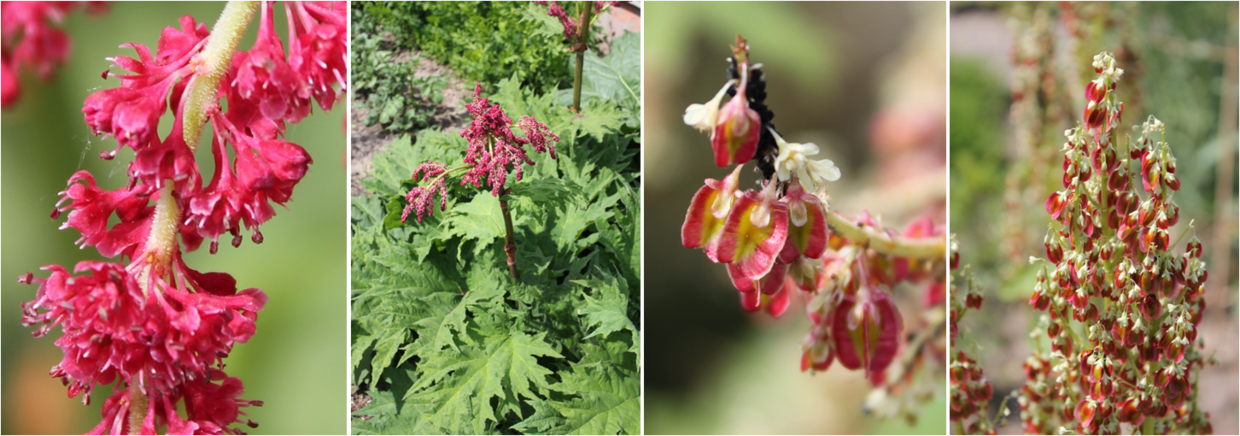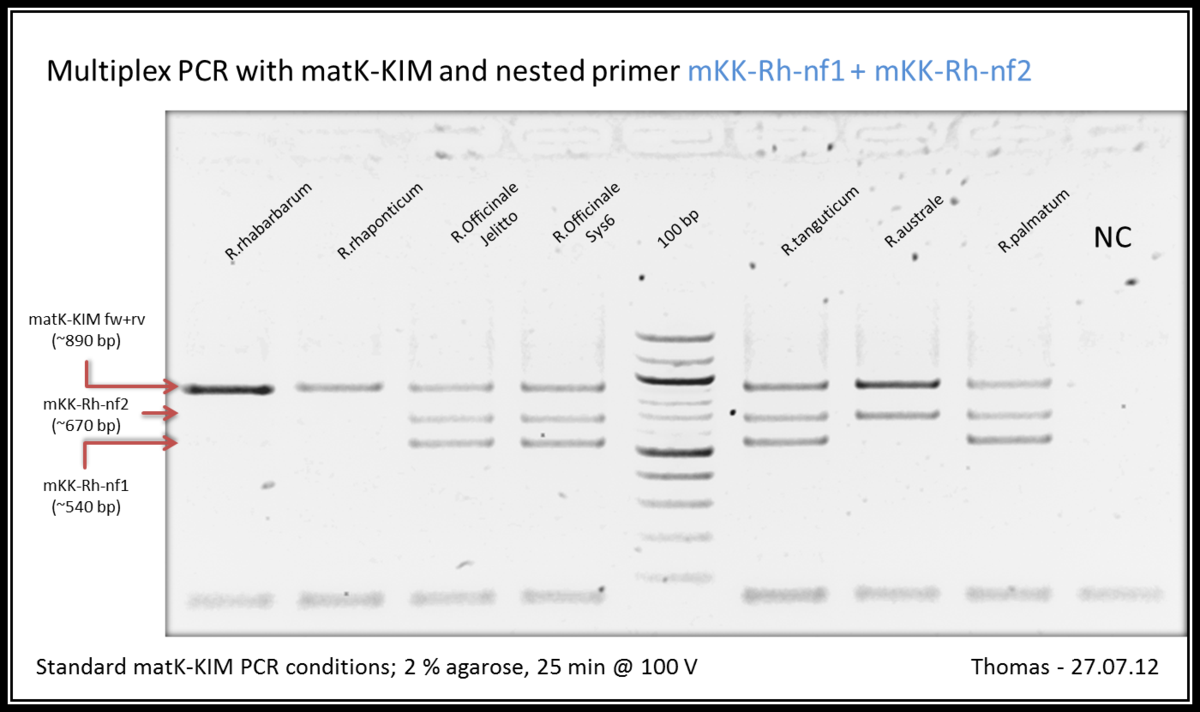Rheum ist eine Gattung der Knöterichgewächse (Polygonaceae) deren ausdauernd krautige Arten im gemäßigten bis subtropischen Asien beheimatet sind. In der traditionellen asiatischen Medizin werden diverse Rheum Arten verwendet. Speziell in der chinesischen Ausrichtung werden die Arten der Sektion Palmata (R. palmatum, R. tanguticum, R. officinale) zur Linderung verschiedenster Beschwerden eingesetzt.
Rheum Arten sind morphologisch nur schwer zu bestimmen und bastardieren gerne. Es ist somit kein Wunder, dass Fälle auftraten, wo eine Rheum Art für eine andere gehalten wurde, und der gewünschte Effekt nicht bzw. eine völlig andere Wirkung eintrat. Beispiele hierfür sind R. rhaponticum und R. australe, welche als Verwechslungsarten der Palmata Arten geführt werden.
Auch in der westlichen Welt ist Rhabarber bekannt und lässt sich in Joghurts, Kuchen und anderen Leckereien finden.
| Titel | Bearbeiter | Typ | Datum |
|---|---|---|---|
| Morphologische und molekularbiologische Charakterisierung ausgewählter Rheum-Akzessionen | Nadja Stöffler, Sara Pierre-Ferrer | F2 PE | 11.06.2015 |
| Rheum – Identification using morphological traits, Tubulin based Polymorphism and DNA-Barcoding | Thomas Hirth | Masterarbeit | 2015 |
| DNA-basierte Authentifizierung von Rheum radix et Rhizoma | Saskia Pfannkuchen | Bachelorarbeit | 26.08.2013 |
Was bisher geschah...
Im botanischen Garten werden mehrere Akzessionen der Palmata Gruppe seit einigen Jahren kultiviert. Wir haben bereits beispielhaft einige der unterirdischen Speicherorgane (Rhizome), welche die Rohdrogen in der traditionellen Medizin sind, geerntet, einen Vollextrakt hergestellt und mittels Dünnschichtchromatograhie analysiert.
Im Bereich DNA Diagnostik haben wir versucht die im Garten vorhandenen Akzessionen mit Hilfe des matK Gens und der Arbeit von Yang et al. 2004 zu authentifizieren. Es wurden außerdem DNA Fingerprint Profile des Tubulin Intron Polymorphismus erstellt welche zusammen mit den Ergebnissen der matK Untersuchung darauf hinweisen, dass die taxonomische Zuordnung unserer Akzessionen stellenweise falsch ist.
Wie es weiter geht...

Im Zug der Masterarbeit von Thomas Hirth werden wir versuchen die Akzessionen morphologisch zu bestimmen und uns die Blüten etwas genauer anschauen. Im Bereich DNA Diagnostik geht es darum, neben dem bereits erhobenen Marker (matK) noch andere zu erheben (ITS und psbA-trnH). Um die Auflösung, die wir bisher mit den klassischen Sequenzmarkern erhalten haben, zu verbessern, werden wir in diesem Jahr zum ersten mal TBP Profile mittels Kapillar-Elektrophorese erstellen lassen. Als Vorbereitung für dieses Pilotprojekt wollen wir die neuen TBP Primer testen und uns die entsprechenden Muster auf Agarose Gelen anschauen.
Referenzen zum Nachlesen...
Chiou, S.J. et al., 2007. Authentication of medicinal herbs using PCR-amplified ITS2 with specific primers. Planta Medica, 73, pp.1421–1426.
Gao, L., Xu, X. & Yang, J., 2013. CHEMICAL CONSTITUENTS OF THE ROOTS OF Rheum officinale. , 49(4), pp.518–520.
He, Z.H. et al., 2011. Anti-angiogenic effect and mechanism of rhein from Rhizoma Rhei. Phytomedicine, 18(6), pp.470–478. Available at: http://dx.doi.org/10.1016/j.phymed.2010.10.006.
Lee, J.H., Kim, J.M. & Kim, C., 2003. Pharmacokinetic analysis of rhein in Rheum undulatum L. Journal of Ethnopharmacology, 84(1), pp.5–9.
Möller, F. et al., 2007. Subtype-specific activation of estrogen receptors by a special extract of Rheum rhaponticum (ERr 731®), its aglycones and structurally related compounds in U2OS human osteosarcoma cells. Phytomedicine, 14(11), pp.716–726.
Peigen, X., Liyi, H. & Liwei, W., 1984. Ethnopharmacologic study of Chinese rhubarb. Journal of ethnopharmacology, 10(3), pp.275–293.
Rokaya, M.B. et al., 2012. Rheum australe D. Don: A review of its botany, ethnobotany, phytochemistry and pharmacology. Journal of Ethnopharmacology, 141(3), pp.761–774. Available at: http://dx.doi.org/10.1016/j.jep.2012.03.048.
Ruirui, L. et al., 2010. Uniformity of karyotypes in Rheum ( Poly gonaceae ), a species-rich genus in the Qinghai-Tibetan Plateau and adjacent regions. Caryologia, 63(1), pp.82–90.
Schulz, V., 2008. Wurzelextrakt aus Sibirischem Rhabarber (Rheum rhaponticum L.) bei 109 Patientinnen mit klimakterischen Beschwerden überlegen wirksam im Vergleich mit Placebo. Komplementäre und Integrative Medizin, 49(3), pp.51–53.
Shaw, P.-C. et al., 2009. Patent applications for using DNA technologies to authenticate medicinal herbal material. Chinese medicine, 4, p.21.
Singh, P.P., Ambika & Chauhan, S.M.S., 2013. Activity-guided isolation of antioxidants from the roots of Rheum emodi. Natural Product Research, 27(10), pp.946–949. Available at: http://www.tandfonline.com/doi/abs/10.1080/14786419.2012.682994.
Smolarz, H.D. et al., 2013. Antimycobacterial effect of extract and its components from rheum rhaponticum. Journal of AOAC International, 96(1), pp.155–160.
Song, B., Stöcklin, J., Gao, Y.Q., et al., 2013. Habitat-specific responses of seed germination and seedling establishment to soil water condition in two Rheum species in the high Sino-Himalayas. Ecological Research, 28(4), pp.643–651.
Song, B., Zhang, Z.Q., et al., 2013. Multifunctional bracts enhance plant fitness during flowering and seed development in Rheum nobile (Polygonaceae), a giant herb endemic to the high Himalayas. Oecologia, 172(2), pp.359–370.
Song, B., Stöcklin, J., Zhang, Z., et al., 2013. Seed and microsite limitation in Rheum nobile , a rare and endemic plant from the subnival zone of Sino-Himalaya. Plant Ecology & Diversity, 6(3-4), pp.503–509. Available at: http://www.tandfonline.com/doi/abs/10.1080/17550874.2013.788568.
Sun, Y. et al., 2012. Rapid radiation of Rheum (Polygonaceae) and parallel evolution of morphological traits. Molecular Phylogenetics and Evolution, 63(1), pp.150–158. Available at: http://dx.doi.org/10.1016/j.ympev.2012.01.002.
Techen, N. et al., 2014. DNA barcoding of medicinal plant material for identification. Current Opinion in Biotechnology, 25, pp.103–110. Available at: http://dx.doi.org/10.1016/j.copbio.2013.09.010.
Wang, A., Yang, M. & Liu, J., 2005. Molecular phylogeny, recent radiation and evolution of gross morphology of the rhubarb genus Rheum (Polygonaceae) inferred from chloroplast DNA trnL-F sequences. Annals of Botany, 96(3), pp.489–498.
Wang, X. et al., 2012. Genetic Variation in Rheum palmatum and Rheum tanguticum (Polygonaceae), Two Medicinally and Endemic Species in China Using ISSR Markers. PLoS ONE, 7(12).
Wang, X.M. et al., 2012. Genetic diversity of the endemic and medicinally important plant rheum officinale as revealed by inter-simpe sequence repeat (ISSR) markers. International Journal of Molecular Sciences, 13(3), pp.3900–3915.
Wang, Z.-W. et al., 2013. Developmental Changes in the Composition of Five Anthraquinones from Rheum palmatum as Quantified by 1 H-NMR. Phytochemical Analysis, 24(4), pp.329–335. Available at: http://doi.wiley.com/10.1002/pca.2414.
Yang, D.-Y. et al., 2004a. Molecular analysis of Rheum species used as Rhei Rhizoma based on the chloroplast matK gene sequence and its application for identification. Biological & pharmaceutical bulletin, 27(3), pp.375–383.
Yang, D.-Y. et al., 2004b. Polymerase chain reaction-restriction fragment length polymorphism (PCR-RFLP) and amplification refractory mutation system (ARMS) analyses of medicinally used Rheum species and their application for identification of Rhei Rhizoma. Biological & pharmaceutical bulletin, 27(5), pp.661–669.
Yanping, H., Wang, L. & Yi, L., 2011. New occurrence of B chromosomes in Rheum tanguticum Maxim . ex Balf . ( Polygonaceae ). , 64(3), pp.320–324.
You, X. et al., 2013. Studies on a rhein-producing endophytic fungus isolated from Rheum palmatum L. Fitoterapia, 85(1), pp.161–168. Available at: http://dx.doi.org/10.1016/j.fitote.2012.12.010.
Zhao, X.H. et al., 2013. Preparative isolation and purification of three stilbene glycosides from the Tibetan medicinal plant Rheum tanguticum maxim. Ex Balf. by high-speed counter-current chromatography. Phytochemical Analysis, 24(2), pp.171–175.


